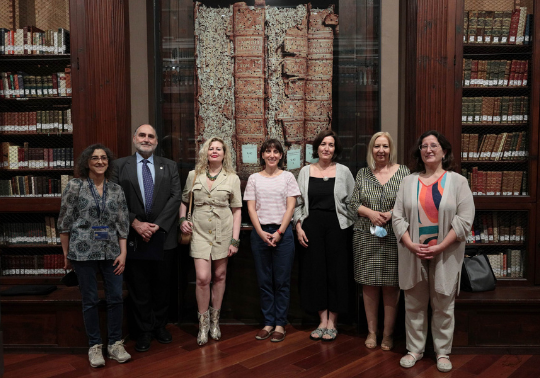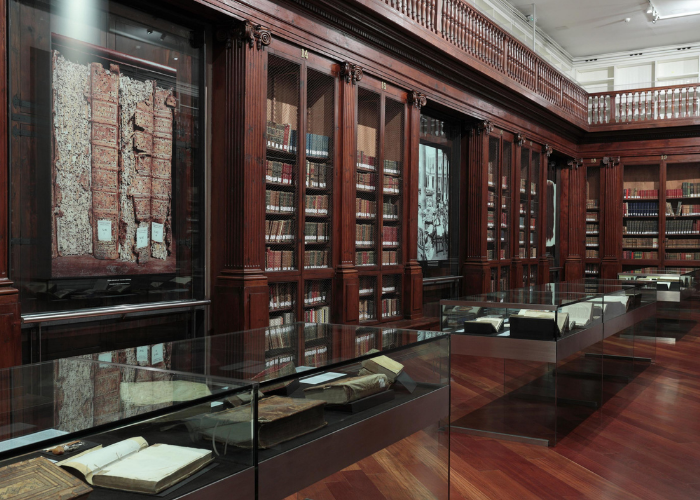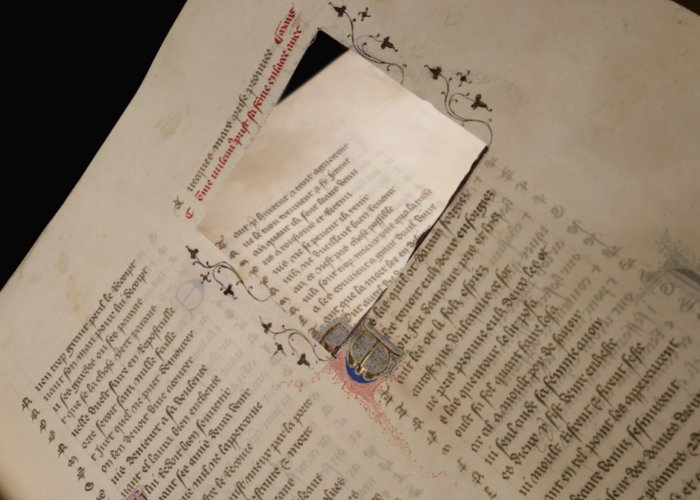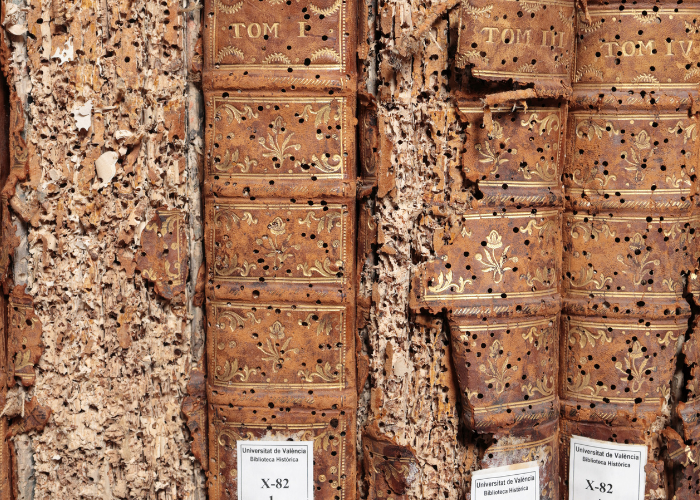
The University of Valencia presents the exhibition 'Malferits. The footprint of time in libraries REBIUN', a project organised by the Vice-Rectorate for Research and the Historical Library that invites us to enter the world of books and learn about the various factors that threaten their survival and conservation. The journey through this little-known aspect of our bibliographic and documentary heritage allows us to observe documents that are not usually included in exhibitions precisely because of the damage they have suffered.
Between 19 May and 4 September, the Duque de Calabria Hall at the La Nau Cultural Centre will house a selection of the collections held at the Biblioteca Històrica, which show their condition as "badly wounded" works.
The exhibition was presented at the opening ceremony, held this Thursday in the Duque de Calabria room of the Biblioteca Històrica, which was attended by the vice-rector for research, Carlos Hermenegildo Caudevilla, the director of the Biblioteca Històrica, María Jesús García Mateu, and the exhibition curators, Susana González Martínez and Mónica Pintado Antúnez, restorers from the Servei de Biblioteques i Documentació de la Universitat de València (Library and Documentation Service of the University of Valencia).
The exhibition is being held as part of the 3rd Conference on Bibliographic Heritage Management organised by the Bibliographic Heritage Working Group of REBIUN (Network of Spanish University Libraries) and the University of Valencia which, on this occasion and on 26 and 27 May, will be held at the Botanical Garden.
Through a selection of more than fifty documents, including seven manuscripts and five incunabula, the main causes capable of altering their integrity, such as the merciless action of censorship; the devastation caused by catastrophes; the effects derived from the degradation of the materials that make them up (paper, inks, bindings); the effect of biological agents, capable of destroying them; and the factor that most affects bibliographic and documentary heritage, whether consciously or simply through ignorance or negligence, which is the human factor.
The exhibition is divided into six sections: "Censorship"; "Disasters"; "Intrinsic causes of deterioration"; "Biodeterioration"; "Human factor" and "Restoration and preventive conservation". The first five of these cover the main causes of deterioration of the bibliographic and documentary collections of the University of Valencia, while the last one deals with general aspects relating to the basic guidelines to be considered for the custody and preservation of documentary and bibliographic heritage. Around these axes, works from the 14th to the 20th centuries, manuscripts, incunabula and rare and curious books that show their wounds are shown.
The first section, "Censorship", shows the action taken by the Inquisition or by the hand of former owners. Among the works on display are the manuscript known as the Cançoner de Maians, which transcribes the works of Joan Roís de Corella and which underwent a process of self-censorship in which the text at the beginning of the work La suplicació de natura humana was cancelled by means of a large ink stain that prevents it from being read; or the incunabulum of Dante Alighieri's work, the Divina commedia, printed in Venice in 1491, victim of inquisitorial action which hid part of the text by sticking pieces of paper over it, visibly damaging the document.
The second section, "Disasters", focuses on the flood that devastated the city of Valencia in 1957. Its effects can be seen in a copy of Luis Vives' work Tratado del socorro de los pobres, printed in Valencia in 1781, on which the layer of mud from the disaster still remains. Also on display are documents preserved in the Arxiu Històric de la Universitat, such as photographs and reports by the restorer Benito Angulo Luengo and the architect Javier Goerlich, direct witnesses of the damage caused to the library and the university building by the catastrophe.
The section "Intrinsic Causes" offers an insight into how the different quality of the materials and the way paper and inks were manufactured have influenced their conservation. Alongside the selected works, a volume of Diderot and d'Alembert's Encyclopédie is displayed, with an engraving of the air-drying of the sheets of paper during their production.
The fourth section, "Biodeterioration", shows the serious problem posed by biological agents to the archives and library collections that were for years the home of insects and rodents. Their effects are reflected in a selection of works with holes, galleries and serious loss of materiality.
In the fifth section, under the heading "The human factor", books mutilated by human greed and damaged by old repair interventions that have proved unfortunate over time are added to this list. This section exhibits a true bibliographical jewel from the 14th century, Roman de la rose, a copy of the Duke of Calabria's collection of codices which, in the 19th century, suffered the merciless mutilation of two of its magnificent miniatures.
The exhibition culminates with the "restoration and preventive conservation" section, which highlights the restoration work that today makes it possible to recover damaged copies, as in the case of the Diari del Compromís de Casp, dated 1412, which was subjected to a mechanical dry reintegration process. Likewise, the importance of daily work in the control of conservation conditions is underlined as a key aspect of preserving heritage collections.
Badly Wounded offers the opportunity to contemplate a different vision to that which is usual in a bibliographic exhibition, with a careful selection of works that form part of the university's bibliographic heritage and which are marked by the scars of their historical development. The Historical Library is responsible for their custody and care, ensuring their conservation and preservation so that their knowledge and inestimable historical value may reach future generations as a legacy that forms part of our identity and our history. Caring for books is an act of responsibility and solidarity, an exercise in cultural enrichment and respect for society.
Images:
.jpg)















